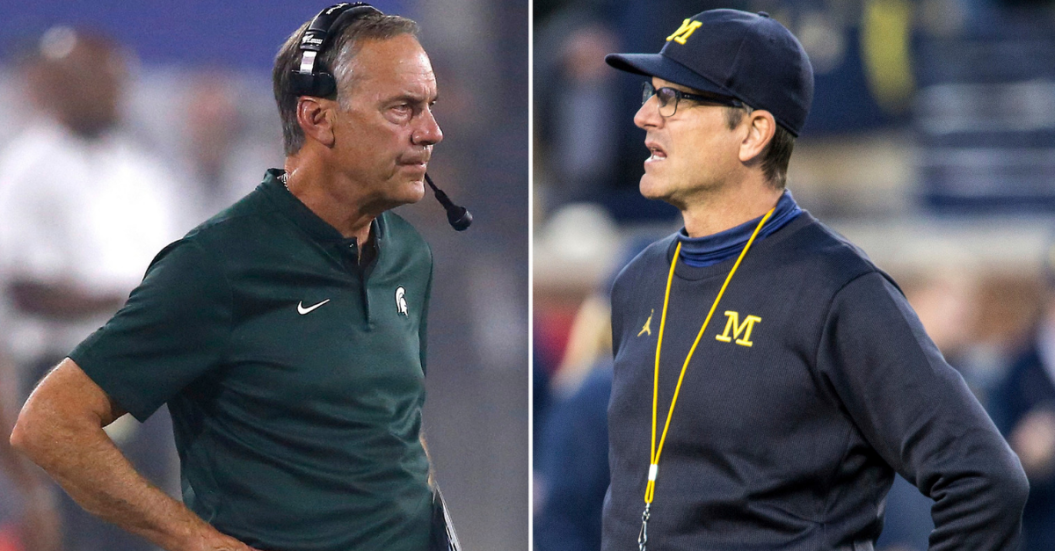The first year the College Football Playoff was introduced, head coach Urban Meyer and the Ohio State Buckeyes won the 2015 National Championship game over the Oregon Ducks. Since that day, the Big Ten Conference has as many wins in the CFP as the Sun Belt Conference.
Videos by FanBuzz
Five years of the playoff have been dominated by the Alabama Crimson Tide and Clemson Tigers, members of the SEC and ACC, respectively. Celebrity analysts will debate which one team is the greatest in college football, but that's just fine with the teams up north in the Big Ten because they're getting filthy rich in the meantime.
According to USA Today, the Big Ten reported nearly $759 million in revenue during the 2017-18 fiscal year. When that money gets divided among the conference's 14 football teams, every school gets a whopping paycheck around $54 million. (Rutgers and Maryland get slightly less because they joined in 2014. That's still a whoooooole lot of money.)
Compare that to the Southeastern Conference, regularly praised as being college football's elite division from top to bottom, which reported $627.1 million in revenue over the same time frame.
If my calculations are correct, that means the Big Ten brought in $131.9 million more than the SEC last year.
So how can a conference with zero College Football Playoff participants in the last two years, and combined for zero points in two games before that, be college football's richest conference?
Depth and television.
Big Ten had nearly $759 million in revenue in FY18, new federal tax return shows. That's up from nearly $513 million last year. It's also $100 million more than amount SEC reported for FY18: https://t.co/Xs4icAPcAG
— Steve Berkowitz (@ByBerkowitz) May 15, 2019
You know what companies like ESPN, ABC, FOX, CBS and NBC want? Money. How do they get that money? By putting things on television that people enjoying watching. Of the 10 most watched games in 2018, five of them featured a Big Ten team, while three were Big Ten Conference matchups. Three of those other games were SEC matchups, all of which featured Alabama.
The Big Ten, Big 12 and Pac-12 all play nine conference games each year while the SEC only plays eight, and those "filler games" for the SEC are typically filled with snoozers so teams can get healthy for the late-season push.
On the same day (Nov. 17, 2018) that the Georgia Bulldogs hung 66 points on Massachusetts (???), the Ohio State Buckeyes survived the Maryland Terrapins, 52-51, on the road in a late-season B1G Conference game. Despite that comparison, and Ohio State actually winning its conference, Georgia finished ahead of OSU in the final CFP rankings.
Big Ten teams beat each other up all year, which hurts them later on, but those added conference games are helping the league rake in the moola.
Quality, year-round competition earned the Big Ten a six-year, $2.64 billion television deal with ESPN and FOX Sports to air major conference games, including Michigan vs. Ohio State, one of the most-watched rivalry games every single year.
https://www.youtube.com/watch?v=UucswABfAYQ
RELATED: This Big Ten Road Trip Takes You to 14 Spectacular Cities and Stadiums
While it would certainly seem like a bigger success to reach the College Football Playoff National Championship game, the Big Ten's depth and quality of football helped make it college football's wealthiest league.
Still, though, that's not enough.
Big Ten Commissioner Jim Delaney, who plans to step down in 2020, helped construct the CFP while making his league as successful as ever. He's just one of many vocal supporters inside the Big Ten who believe the current four-team format is too small and needs to expand.
"I'm open to the consideration and to looking at it and to thinking about it. Anytime our Big Ten champion is left out of the playoff... that's something that needs to be discussed. Because I obviously believe that you go through and you win the Big Ten championship in this league, you've accomplished something that deserves to put you in position to play for the national championship."
— Michigan athletic director Warde Manuel, h/t MLive.com
Only time will tell when the College Football Playoff could expand, but it appears more and more likely that could happen after the current TV and broadcasting deals expire.
Until then, the Big Ten will have to sit on their pile of money and wave at everyone saying this league isn't a dominant conference in the college football landscape.
